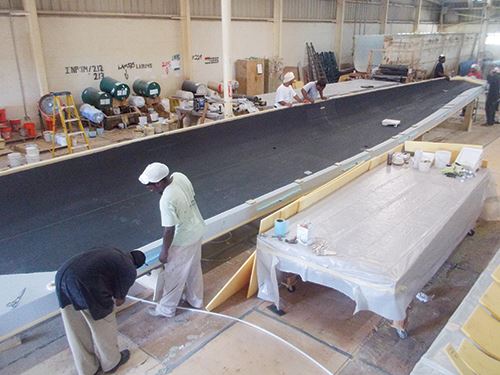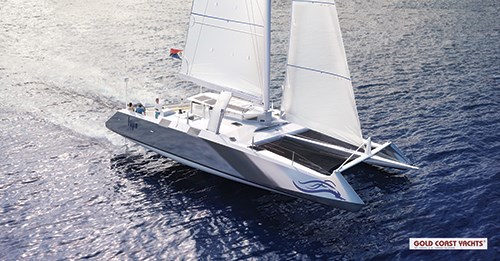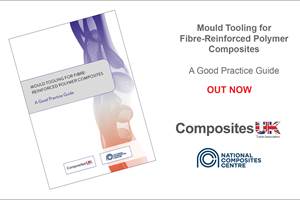First all-carbon yacht a winner
Vacuum infusion with customized fabrics enables demanding yacht build
Gold Coast Yachts (Christiansted, St. Croix, US Virgin Islands) is a 30-year old boatbuilder with a portfolio of 113 custom multihulls for the yacht market, ranging in length from 12m to 30m. Over the years, its construction methods had evolved: It had begun with wood/epoxy and then moved into composites, with hand layup of dry fiberglass, wet out with epoxy via the bucket-and-brush method. Later, Gold Coast adopted wet-bagging methods, where reinforcements are wet out by hand or with a wet-preg machine (impregnator), then layed up on the mold, vacuum bagged and cured at room temperature, relying on the exotherm in the resin. Most recently, the boatbuilder has incorporated some vacuum-infused carbon fiber for selected composite elements.
In the face of strong competition, however, Gold Coast recently won a contract to build its first all-carbon boat, the B53, for competitive racing as well as comfortable cruising. To realize the B53, carbon fiber was required to meet weight and engineering requirements, but prepreg was too costly. The company was concerned about wet bagging of carbon materials, but infusion on that scale seemed problematic as well because a common fear is that smaller-diameter carbon fiber filaments might pack together more tightly than E-glass does and make resin wetout of the fiber difficult. The company contacted Philip Steggall, now the director of North American business development for FORMAX (Leicester, UK) and a long-time marine composites expert, for advice on what materials and process might best meet the laminate performance specified by the vessel’s designer, Paul Bieker of naval architecture firm Bieker Boats LLC (Seattle, WA, US). Steggall suggested a testing program to compare wet bagging and vacuum infusion. Identical laminate panels were created with both methods, using FORMAX stitched biaxial fabrics and resins appropriate for both methods. The test results, from several laboratories, showed that the vacuum-infused panels exhibited superior properties, including a 15% gain in compression strength. The wet-bagged panels, Steggall reports, were inconsistent in fiber volume and had significantly higher void content. The high-viscosity resin used in wet-bagging does not travel through the carbon and expel air as well as a lower viscosity infusion resin will, he reports, adding that the fiber content for the infused panel was consistently within 2% tolerance, with no noticeable voids. Armed with this information, Gold Coast decided it could meet the challenging specifications with infusion and use lower-cost molds and lower cure temperatures than prepreg demand.
FORMAX developed custom biaxial carbon fabrics, ±45°, at areal weights of 400 g/m2 and 300 g/m2, and another 0°/90° biaxial of 300 g/m2, which were optimized for the infusion process. To facilitate air evacuation and enable resin flow through the laminate layers, a thin, randomly oriented monofilament web of polyamide fibers was placed between the carbon plies, FORMAX reports. Additionally, the stitched multiaxials perform better during infusion processes than woven or hot-melt-bonded fabrics, says the company, because they offer z-axis air-escape routes along the threads through the thickness, resulting in fewer voids.
“The FORMAX fabrics allowed us to get air out ahead of the resin front, instead of entrapping it within the laminate, as can happen with wet bagging, and even with prepreg,” reports Gold Coast Yachts’ president Rich Difede. “That’s how we hit the target weight as well as the strength requirement for this boat,”
“Some remain skeptical about the quality and properties of infused carbon laminates,” adds Steggall, but maintains, “Our work with Gold Coast Yachts proves that infusion, when done correctly, yields a significant strength advantage. Part of the story is training of the personnel and part is material choice.”
The B53, now renamed Fūjin, has an overall length of 16.3m, a displacement of 5,500 kg, and was launched this year, at the end of May.
Related Content
Chemnitz University of Technology receives €6 million to expand research into "green" carbon fiber
Carbon LabFactory and InnoCarbEnergy project conduct R&D across entire value chain from raw materials through processes to structures and systems on a pilot line with technology demonstrators.
Read MoreComposites UK launches best practice guide for composites tooling
“Mould Tooling for Fibre-Reinforced Polymer Composites” is latest in Composites UK’s series of good practice guides, available online for free.
Read MoreThe Native Lab launches composites course training membership plan
Courses that touch on the fundamentals of composite materials, design, analysis and more are available for individuals and companies alike through TNL’s online platform.
Read MoreZeiss, Imperial College London summer school enhances materials, sustainability learning
Twenty-four next-generation students attended the Imperial College London this August to advance their scientific knowledge, with workshops, lectures, activities and a composites competition.
Read MoreRead Next
Developing bonded composite repair for ships, offshore units
Bureau Veritas and industry partners issue guidelines and pave the way for certification via StrengthBond Offshore project.
Read MorePlant tour: Daher Shap’in TechCenter and composites production plant, Saint-Aignan-de-Grandlieu, France
Co-located R&D and production advance OOA thermosets, thermoplastics, welding, recycling and digital technologies for faster processing and certification of lighter, more sustainable composites.
Read MoreVIDEO: High-volume processing for fiberglass components
Cannon Ergos, a company specializing in high-ton presses and equipment for composites fabrication and plastics processing, displayed automotive and industrial components at CAMX 2024.
Read More
























